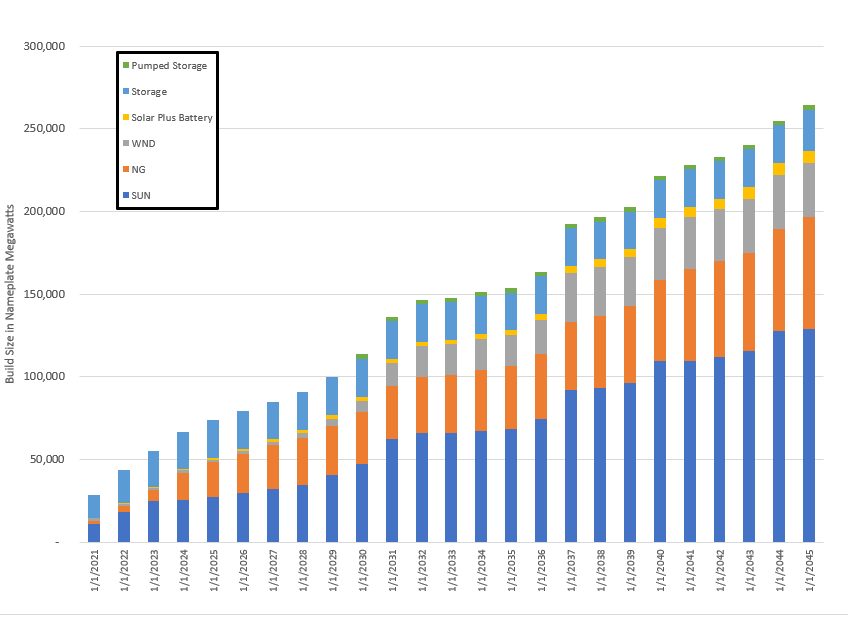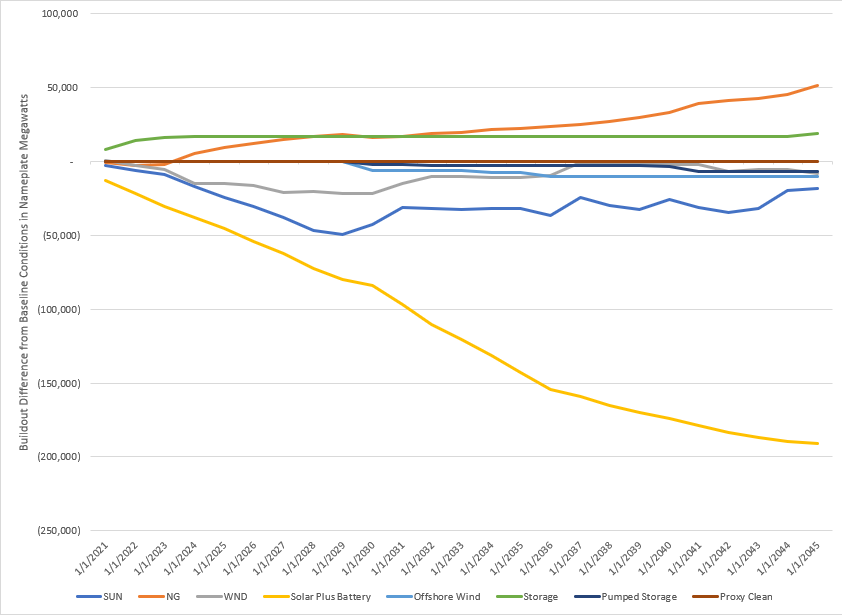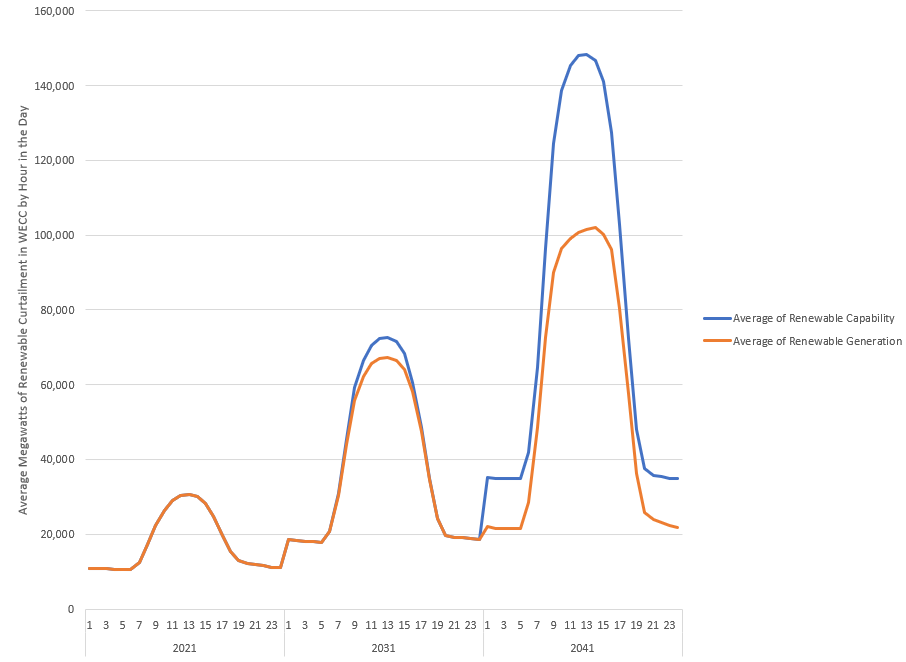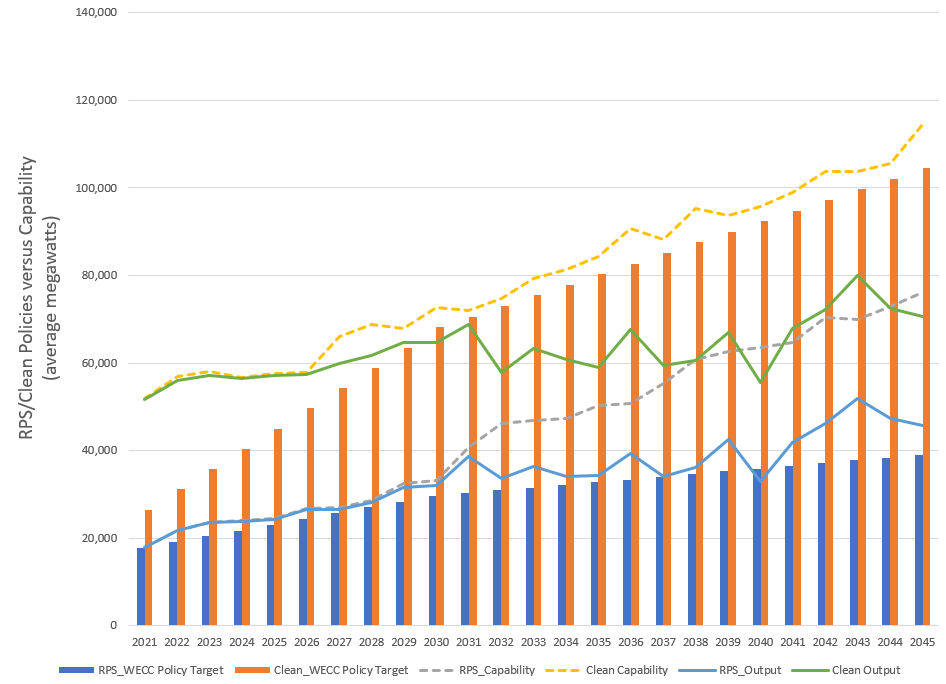The resource buildout of the western grid used to support the no gas build limitations scenario pricing and analyses incorporates many of the common assumptions that are used throughout the scenario work, but also removes limitations on gas plant builds [1] throughout the western grid that is an assumption throughout the other scenarios and the baseline.
The associated buildout is significantly smaller than the baseline. The significantly larger build of new gas[2] resources fulfills load growth and reserve margins more efficiently than builds that have less gas and are primarily renewable generation. This study does still does build zero or lower emissions resources early but primarily because they have lower production and fixed costs.
No Gas Build Limit buildout

The buildout in the WECC-wide emissions pricing study included just under 228 gigawatts of nameplate build by 2041 as seen in the figure above. More than 50% of the new resource buildout was either stand-alone solar or solar plus battery hybrid resources, and over 64% of the buildout was solar or wind. Like in the baseline, significant amount of the renewable buildout appears to be to attempt to meet the policies enacted by states or municipal governments, and/or goals by utilities and further increased renewable and storage resource builds.
As can be seen below, significantly less stand-alone solar and hybrid solar plus storage is built throughout the study. Additionally, as would be expected the new gas build is larger and the difference grows over time in comparison to the baseline. Increased gas generation does in fact displace existing coal and inefficient gas plant dispatch.
Build Comparison to Baseline

Like the baseline, but to a significantly lesser extent, a large amount of renewable generation is built, causing renewable curtailment[3] to become more prevalent throughout time, especially during midday hours. In 2021, as can be seen in the graph below, the maximum renewable generation curtailment in any hour of the day averaged just over 20 megawatts and by 2041 grew to over 47,000 megawatts. This is significantly less renewable curtailment in the no gas build limit study than in the baseline.
Renewable Curtailment

This extensive renewable curtailment made it challenging to enforce compliance with some of the clean policies and goals with the current technologies as can be seen in the graph below. By 2030, with current system operations,[4] transmission infrastructure and the assumed buildout the system is forecasted to not be able to meet all of obligations implied by the clean policies and goals[5] even though the buildouts contain sufficient capability to generate that much power. The state renewable
Clean Policy Versus Capability Baseline

The following spreadsheets contain further supporting information on the no gas build limit scenario buildout:
Buildout Information for No Gas Build Limit Scenario
Buildout Comparison to Baseline Conditions
Renewable Curtailment in No Gas Build Limit Scenario
[1] Initial studies showed upwards of 70 nameplate gigawatts of gas, but advisory committee and Council feedback made it clear that was much higher than the expected gas plant build. Thus, for the baseline gas plant build was limited, but the removal of those limits was tested in this sensitivity.
[2] Nearly 35 gigawatts more nameplate build in gas plants by 2041.
[3] Renewable power is often limited by how much “fuel”, insolation and wind, is available at any given time. Sometimes, more power is generated than is needed, or can be sunk to the grid due to transmission, demand or operational constraints on other generators. In this case, the power is “curtailed” or “spilled.”
[4] It is possible that revised system operations or different policy structure might reduce renewable curtailment, but the current market structure is devised to reduce production cost not to eliminate emissions.
[5] From a physical compliance inside the WECC perspective, there may be alternative compliance methods. This scenario in particular would have to leverage heavily on these alternative measures to meet state policies and obligations.



